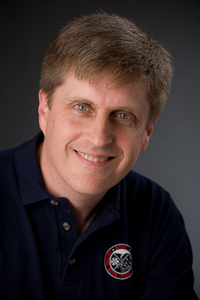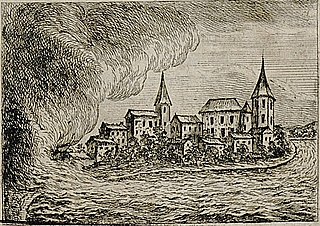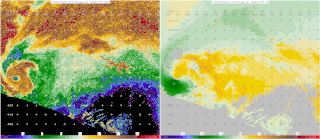These are some notable tornadoes, tornado outbreaks, and tornado outbreak sequences that have occurred around the globe.
- Exact death and injury counts are not possible; especially for large events and events before 1955.
- Prior to 1950 in the United States, only significant tornadoes are listed for the number of tornadoes in outbreaks.
- Due to increasing detection, particularly in the U.S., numbers of counted tornadoes have increased markedly in recent decades although the number of actual tornadoes and counted significant tornadoes has not. In older events, the number of tornadoes officially counted is likely underestimated.
This is a list of meteorology topics. The terms relate to meteorology, the interdisciplinary scientific study of the atmosphere that focuses on weather processes and forecasting.
The National Severe Storms Laboratory (NSSL) is a National Oceanic and Atmospheric Administration (NOAA) weather research laboratory under the Office of Oceanic and Atmospheric Research. It is one of seven NOAA Research Laboratories (RLs).
The Enhanced Fujita scale rates tornado intensity based on the severity of the damage they cause. It is used in some countries, including the United States and France. The EF scale is also unofficially used in other countries, including China.
The Tornado and Storm Research Organisation (TORRO) was founded by Terence Meaden in 1974. Originally called the Tornado Research Organisation, it was expanded in 1982 following the inclusion of the Thunderstorm Census Organisation (TCO) after the death of its founder Morris Bower and his wife. The current Head of TORRO is Paul Knightley, a professional meteorologist.

Tornadoes have been recorded on all continents except Antarctica. They are most common in the middle latitudes where conditions are often favorable for convective storm development. The United States has the most tornadoes of any country, as well as the strongest and most violent tornadoes. A large portion of these tornadoes form in an area of the central United States popularly known as Tornado Alley. Canada experiences the second most tornadoes. Ontario and the prairie provinces see the highest frequency. Other areas of the world that have frequent tornadoes include significant portions of Europe, South Africa, Philippines, Bangladesh, parts of Argentina, Uruguay, and southern and southeastern Brazil, northern Mexico, eastern and western Australia, New Zealand, and far eastern Asia.

Harold Edward Brooks is an American meteorologist whose research is concentrated on severe convective storms and tornadoes, particularly severe weather climatology, as well as weather forecasting.

The Verification of the Origins of Rotation in Tornadoes Experiment are field experiments that study tornadoes. VORTEX1 was the first time scientists completely researched the entire evolution of a tornado with an array of instrumentation, enabling a greater understanding of the processes involved with tornadogenesis. A violent tornado near Union City, Oklahoma was documented in its entirety by chasers of the Tornado Intercept Project (TIP) in 1973. Their visual observations led to advancement in understanding of tornado structure and life cycles.
The European Storm Forecast Experiment, known as ESTOFEX, is an initiative of a team of European meteorologists, and students in meteorology founded in 2002. It serves as a platform for exchange of knowledge about forecasting severe convective storms in Europe and elsewhere. It is a voluntary organisation and is currently unfunded. It aims to raise awareness and provide real-time education about severe weather forecasting. ESTOFEX issues storm warnings on a daily basis. It also collects reports from the general public about severe convective weather incidents in order to validate its forecasts. Reports should be submitted to the European Severe Weather Database (ESWD).
The following is a glossary of tornado terms. It includes scientific as well as selected informal terminology.
The International Fujita scale rates the intensity of tornadoes and other wind events based on the severity of the damage they cause. It is used by the European Severe Storms Laboratory (ESSL) and various other organizations including Deutscher Wetterdienst (DWD) and State Meteorological Agency (AEMET). The scale is intended to be analogous to the Fujita and Enhanced Fujita scales, while being more applicable internationally by accounting for factors such as differences in building codes.

This is a list of notable tornadoes and tornado outbreaks worldwide in 2023. Strong, destructive tornadoes form most frequently in the United States, Argentina, Brazil, Bangladesh and East India, but can occur almost anywhere. Tornadoes develop occasionally in southern Canada during the Northern Hemisphere's summer, and at other times of the year across Europe, Asia, Argentina, Australia and New Zealand. They are often accompanied by other forms of severe weather, including thunderstorms, strong winds, and large hail. Worldwide, 116 tornado-related deaths were confirmed – 83 in the United States, 12 in China, nine in Indonesia, eight in Myanmar, three in Turkey, and one in Saudi Arabia.

The 1764 Woldegk tornado on June 29, 1764, was one of the strongest tornadoes ever documented in history, receiving the unique T11 rating on the TORRO scale along with an F5 rating on the Fujita scale and had winds estimated to be more than 480 kilometres per hour (300 mph). The tornado traveled 30 kilometres (19 mi) and reached a maximum width of 900 metres (980 yd). Most of the information known about this tornado came from a detailed 77-paragraph study by German scientist Gottlob Burchard Genzmer, which was published one year after the tornado occurred. The tornado completely destroyed several structures, and several tree branches reportedly thrown into the atmosphere. Many areas were covered with up to 2 centimetres (0.8 in) of ice. The storm which produced the violent tornado was dry, with almost no rain reported. Large hail, reportedly reaching 15 centimetres (6 in) in diameter covered the ground. The hail caused significant crop and property damage, killed dozens of animals, and injured multiple people in a large stretch around the tornado and to the northwest of the tornado's path.
This is a timeline of scientific and technological advancements as well as notable academic or government publications in the area of atmospheric sciences and meteorology during the 21st century. Some historical weather events are included that mark time periods where advancements were made, or even that sparked policy change.

The history of tornado research spans back centuries, with the earliest documented tornado occurring in 200 and academic studies on them starting in the 18th century. This is a timeline of government or academic research into tornadoes.






